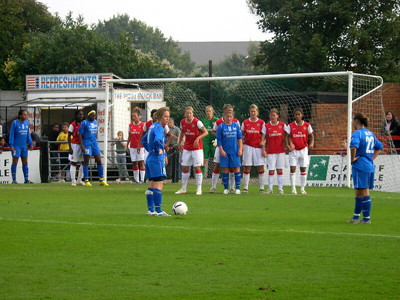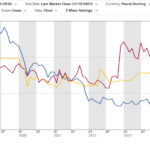Are you curious about the exact height of a football goal? The standard height for a full-size football goal is 8 feet (2.44 meters). This article will dive into the specific dimensions of football goals at various levels, from professional leagues to youth games, and highlight essential safety guidelines. At CAUHOI2025.UK.COM, we’re dedicated to providing clear, reliable answers to all your questions.
Looking for detailed information on football goal dimensions, safety regulations, or related topics? Explore CAUHOI2025.UK.COM for comprehensive answers and expert guidance on football equipment and field specifications.
1. Standard Football Goal Dimensions: The Basics
 Football Goal Size
Football Goal Size
For professional and adult-level football, the goal dimensions are strictly regulated to ensure fair play. According to the Football Association and FIFA, a standard football goal must be 8 feet (2.44 meters) in height and 24 feet (7.32 meters) in width. These dimensions apply to goals used in major leagues like the Premier League, Major League Soccer (MLS), and international competitions.
1.1 The Importance of Standardized Goal Sizes
Maintaining consistent goal sizes across different venues is crucial for the integrity of the sport. Standardized dimensions eliminate any potential advantage one team might have due to variations in goal size. This ensures that the game remains fair and competitive, regardless of the location.
1.2 Official Regulations and Governing Bodies
FIFA (Fédération Internationale de Football Association) and national football associations such as The Football Association (FA) in England set the standards for goal dimensions. These organizations ensure that all affiliated leagues and competitions adhere to the specified measurements, promoting uniformity and fairness in the sport.
2. Goal Size Variations for Different Age Groups
While professional football uses standard-sized goals, smaller goals are employed in youth leagues to suit the physical capabilities of younger players. Adjusting goal sizes allows young players to develop their skills appropriately and makes the game more enjoyable.
2.1 Youth Football Goal Dimensions
Different age groups use different goal sizes to match their physical development. Here’s a breakdown of the standard goal sizes for youth football:
| Age Group | Height (Feet) | Width (Feet) |
|---|---|---|
| Under 7s – Under 8s | 6 | 12 |
| Under 9s – Under 10s | 6 | 12 |
| Under 11s – Under 12s | 7 | 16 |
| Under 13s – Under 14s | 7 | 21 |
| Under 15s – Under 16s | 8 | 24 |
| Under 17s – Under 18s | 8 | 24 |
This table illustrates how goal sizes gradually increase as players grow older, allowing for a progressive development of skills and physical abilities.
2.2 Rationale Behind Varied Goal Sizes
Using smaller goals for younger age groups makes scoring more achievable and encourages greater participation. Smaller goalkeepers have a better chance of defending their goal, and players are more likely to experience success, fostering a love for the game. As players mature, the goal sizes increase to challenge their developing skills and prepare them for higher levels of competition.
3. Ensuring Goalpost Safety: Guidelines and Best Practices
 back-pass
back-pass
Goalpost safety is paramount to prevent injuries and ensure a secure playing environment. Accidents involving unsecured or improperly maintained goals can lead to severe consequences. Therefore, adhering to safety guidelines is essential for all football organizations and facilities.
3.1 Key Safety Regulations
The Football Association and other governing bodies provide specific safety guidelines for goalposts:
- Secure Anchoring: Portable goals must be securely anchored to the ground. Weighted bars or ground anchors should be used to prevent tipping.
- Manufacturer Instructions: Always follow the manufacturer’s instructions for setting up and securing goals.
- Prohibited Activities: Climbing on, swinging from, or placing excessive weight on goalposts is strictly prohibited.
- Proper Storage: When not in use, portable goals should be stored in a secure location, lying flat on the ground to prevent accidental falls.
- Regular Inspections: Regularly inspect goalposts for damage or instability. Replace or repair any faulty equipment immediately.
3.2 Standards and Compliance
Adhering to safety standards is crucial. While wooden goals may not meet current safety requirements, goals made of UPVC, aluminum, or metal should comply with recognized safety standards. Regular inspections and maintenance are essential to ensure ongoing compliance.
4. The Legal Framework Surrounding Football Goal Dimensions and Safety in the US
In the United States, while there isn’t a single federal law dictating football goal dimensions and safety, various organizations and state regulations contribute to a comprehensive framework.
4.1 Organizational Standards
Organizations like the National Federation of State High School Associations (NFHS) set standards for high school football, including goal dimensions and safety. These standards are widely adopted by state athletic associations.
4.2 State Regulations
Many states have their own regulations regarding sports equipment safety, which may include specific requirements for football goals. These regulations often reference or incorporate standards from organizations like NFHS.
4.3 Liability and Negligence
Failure to adhere to established safety standards can result in liability issues. If an injury occurs due to a poorly maintained or improperly secured goal, the responsible party (e.g., school, league, or facility) may be held liable for negligence.
4.4 Consumer Product Safety Commission (CPSC)
While the CPSC doesn’t specifically regulate football goals, they provide general guidelines on sports equipment safety, which can be relevant. The CPSC also monitors injuries associated with sports equipment and may issue recalls or safety alerts if necessary.
5. How Goal Dimensions Impact the Game
The size of the goal significantly influences the dynamics of a football match. Different goal sizes affect scoring rates, goalkeeper performance, and overall game strategy.
5.1 Impact on Scoring Rates
Smaller goals, used in youth football, generally lead to higher scoring rates because they are easier for young players to target. Conversely, standard-sized goals in professional football present a greater challenge, requiring more precise shots and strategic plays.
5.2 Goalkeeper Performance
Goal size directly affects the performance of goalkeepers. In youth games with smaller goals, goalkeepers can more effectively cover the net, boosting their confidence and skill development. In professional matches, goalkeepers must possess exceptional agility, reflexes, and positioning to defend the larger goal.
5.3 Strategic Implications
Coaches must develop different strategies based on the goal size. In youth football, the focus may be on developing shooting accuracy and teamwork, whereas, in professional football, tactics often involve intricate passing sequences and set-piece plays designed to exploit the larger goal area.
6. Innovations in Goalpost Technology
Advancements in goalpost technology have focused on improving safety, durability, and performance. Modern goalposts are designed to withstand rigorous use while minimizing the risk of injury.
6.1 Materials and Design
Modern goalposts are typically made from aluminum, steel, or reinforced plastics. These materials offer a combination of strength, lightweight construction, and weather resistance. Innovative designs include features like rounded edges and padded surfaces to reduce the risk of impact injuries.
6.2 Safety Features
Many modern goalposts incorporate advanced safety features such as breakaway systems that allow the goal to collapse upon impact, reducing the force of a collision. Additionally, some goals are equipped with built-in anchoring systems that provide enhanced stability and prevent tipping.
6.3 Future Trends
Future innovations in goalpost technology may include smart goals equipped with sensors to detect and record goals accurately. These technologies could enhance the fairness and precision of the game while providing valuable data for analysis and training.
7. Choosing the Right Goal for Your Needs
Selecting the appropriate football goal depends on several factors, including the age and skill level of the players, the intended use (practice or competition), and budget considerations.
7.1 Factors to Consider
- Age Group: Ensure that the goal size is appropriate for the age group of the players.
- Intended Use: Consider whether the goal will be used for practice, recreational games, or competitive matches.
- Portability: Decide whether you need portable goals that can be easily moved or permanent goals that are securely installed.
- Budget: Set a budget and explore options that offer the best value for your money.
- Safety Features: Prioritize goals with safety features such as secure anchoring systems and padded surfaces.
7.2 Types of Goals
- Regulation Goals: These are full-size goals used in professional and adult-level football.
- Youth Goals: These smaller goals are designed for younger players and come in various sizes.
- Portable Goals: These lightweight goals can be easily transported and set up on different fields.
- Pop-Up Goals: These are small, collapsible goals ideal for recreational use and backyard games.
8. Maintenance Tips for Longevity and Safety
Proper maintenance is essential to prolong the life of your football goals and ensure they remain safe for use. Regular inspections, cleaning, and repairs can prevent accidents and keep your goals in optimal condition.
8.1 Regular Inspections
Inspect your goals regularly for signs of damage, such as cracks, dents, or loose connections. Pay close attention to anchoring systems and ensure they are securely fastened.
8.2 Cleaning and Storage
Clean your goals regularly to remove dirt, debris, and moisture. Store portable goals in a dry, secure location when not in use to prevent damage from weather or vandalism.
8.3 Repairs and Replacements
Repair any damage promptly using appropriate tools and materials. Replace worn or damaged parts as needed to maintain the structural integrity of the goals.
9. Frequently Asked Questions (FAQs) About Football Goal Dimensions
9.1 What is the official height of a football goal?
The official height of a standard football goal is 8 feet (2.44 meters).
9.2 What is the official width of a football goal?
The official width of a standard football goal is 24 feet (7.32 meters).
9.3 What size goals are used for Under-12 football?
Under-12 football typically uses goals that are 7 feet high and 16 feet wide.
9.4 Are goal dimensions the same in all professional leagues?
Yes, goal dimensions are standardized in professional leagues to ensure fair play.
9.5 How important is goalpost safety?
Goalpost safety is extremely important to prevent injuries and ensure a safe playing environment.
9.6 What should I do if I find a damaged goalpost?
If you find a damaged goalpost, report it immediately and ensure it is repaired or replaced before use.
9.7 Can I use homemade goals for official matches?
No, homemade goals are not allowed for official matches due to safety concerns.
9.8 How often should I inspect my football goals?
You should inspect your football goals regularly, ideally before each use, to ensure they are in good condition.
9.9 What are the key safety guidelines for portable goals?
Key safety guidelines for portable goals include secure anchoring, following manufacturer instructions, and proper storage when not in use.
9.10 Where can I find more information about football safety regulations?
You can find more information about football safety regulations on the websites of FIFA, The Football Association, and other governing bodies.
10. CAUHOI2025.UK.COM: Your Go-To Resource for Football Information
At CAUHOI2025.UK.COM, we are committed to providing accurate, reliable, and easy-to-understand information on all aspects of football. Whether you’re a player, coach, parent, or fan, our goal is to be your trusted resource for everything football-related.
10.1 Why Choose CAUHOI2025.UK.COM?
- Comprehensive Information: We offer in-depth articles, guides, and resources on a wide range of football topics.
- Expert Advice: Our content is created by experienced football professionals and knowledgeable researchers.
- Reliable Sources: We cite reputable sources and governing bodies to ensure accuracy and credibility.
- User-Friendly: Our website is designed to be easy to navigate, so you can quickly find the information you need.
10.2 Need More Answers? Contact Us!
Do you have more questions about football goal dimensions, safety regulations, or any other football-related topic? Visit CAUHOI2025.UK.COM today to explore our extensive collection of articles and resources. If you need further assistance, don’t hesitate to contact us. Our team is here to help you find the answers you need and enhance your understanding of the beautiful game. You can reach us at Equitable Life Building, 120 Broadway, New York, NY 10004, USA or call +1 (800) 555-0199. Alternatively, visit our “Contact” page on CauHoi2025.UK.COM for more options.

